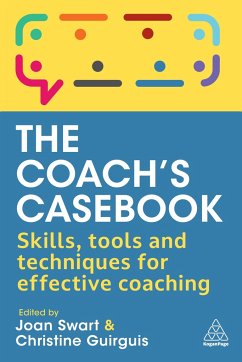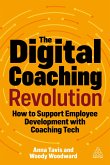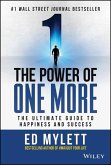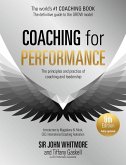The Coach's Casebook
Skills, Tools and Techniques for Effective Coaching
Herausgeber: Swart, Joan; Guirguis, Christine
26,99 €
inkl. MwSt.
Sofort lieferbar

13 °P sammeln
The Coach's Casebook
Skills, Tools and Techniques for Effective Coaching
Herausgeber: Swart, Joan; Guirguis, Christine
- Broschiertes Buch
- Merkliste
- Auf die Merkliste
- Bewerten Bewerten
- Teilen
- Produkt teilen
- Produkterinnerung
- Produkterinnerung
Master the theory and skills needed to support employees and coach them to reach their full potential.
Andere Kunden interessierten sich auch für
![The Voice Coach's Toolkit The Voice Coach's Toolkit]() Pamela PratherThe Voice Coach's Toolkit34,99 €
Pamela PratherThe Voice Coach's Toolkit34,99 €![The Digital Coaching Revolution The Digital Coaching Revolution]() Anna TavisThe Digital Coaching Revolution28,99 €
Anna TavisThe Digital Coaching Revolution28,99 €![The Power of One More The Power of One More]() Ed MylettThe Power of One More19,99 €
Ed MylettThe Power of One More19,99 €![My Life in Full My Life in Full]() Indra NooyiMy Life in Full12,99 €
Indra NooyiMy Life in Full12,99 €![Coaching for Performance, 6th edition Coaching for Performance, 6th edition]() Sir John WhitmoreCoaching for Performance, 6th edition19,99 €
Sir John WhitmoreCoaching for Performance, 6th edition19,99 €![Full Out Full Out]() Monica AldamaFull Out26,99 €
Monica AldamaFull Out26,99 €![My Life in Full My Life in Full]() Indra NooyiMy Life in Full10,99 €
Indra NooyiMy Life in Full10,99 €-
-
-
Master the theory and skills needed to support employees and coach them to reach their full potential.
Hinweis: Dieser Artikel kann nur an eine deutsche Lieferadresse ausgeliefert werden.
Hinweis: Dieser Artikel kann nur an eine deutsche Lieferadresse ausgeliefert werden.
Produktdetails
- Produktdetails
- Verlag: Kogan Page Ltd
- Seitenzahl: 432
- Erscheinungstermin: 3. Juli 2023
- Englisch
- Abmessung: 244mm x 170mm x 28mm
- Gewicht: 716g
- ISBN-13: 9781398610477
- ISBN-10: 139861047X
- Artikelnr.: 65179699
- Herstellerkennzeichnung
- Libri GmbH
- Europaallee 1
- 36244 Bad Hersfeld
- gpsr@libri.de
- Verlag: Kogan Page Ltd
- Seitenzahl: 432
- Erscheinungstermin: 3. Juli 2023
- Englisch
- Abmessung: 244mm x 170mm x 28mm
- Gewicht: 716g
- ISBN-13: 9781398610477
- ISBN-10: 139861047X
- Artikelnr.: 65179699
- Herstellerkennzeichnung
- Libri GmbH
- Europaallee 1
- 36244 Bad Hersfeld
- gpsr@libri.de
Dr Joan Swart is a coaching psychologist, accredited supervisor, researcher and author. Based in Cape Town, South Africa, she is the Corporate Programme Director at Coaching Minds. She developed the curriculum of the Jay Shetty Certification School and is an accredited supervisor at the Association for Coaching. Christine Guirguis is an Association For Coaching Certified Productivity and Performance Coach. She founded Advaya Project which provides people with the tools they need to reach their true potential. She is based in Cairo, Egypt.
Chapter
01: Introduction and misconceptions of coaching; Section
ONE: Models and frameworks; Chapter
02: The three Cs of coaching and professional practice; Chapter
03: Awareness and accountability in coaching; Chapter
04: Building habits; Section
TWO: Competencies; Chapter
05: Coach supervision
who needs it?; Chapter
06: Coaching presence; Chapter
07: The importance of self
management for a coach; Chapter
08: Are you listening to listening ? The art of listening; Chapter
09: The power of non
directive questioning; Chapter
10: Clarity from heart
brain connection to self
discovery; Chapter
11: Seeking transformation versus focusing on solutions; Section
THREE: Approaches; Chapter
12: Holistic transformation; Chapter
13: Neuroscience
based coaching; Chapter
14: Masculine/feminine energy aspects in coaching; Chapter
15: Mindfulness and psychological flexibility in emotion
based coaching; Section
FOUR: Techniques and tools; Chapter
16: Embodiment; Chapter
17: Identifying and challenging blind spots in coaching; Chapter
18: Coaching tools and techniques; Chapter
19: The eyes watch but the brain sees
Visualization as a coaching tool for shifting the client's present view; Chapter
20: The Wheel of Life; Section
FIVE: Transforming theory into practice
Application and implementation; Chapter
21: Transitioning from theory to practice; Chapter
22: Imposter syndrome; Chapter
23: Ikigai; Chapter
24: Preventing burnout by attaining a healthy work and personal life balance; Chapter
25: Combining coaching and mindfulness; Chapter
26: Establishing an effective coaching dialogue; Chapter
27: Expanding modes of mind
From doing to being and becoming; Chapter
28: The power of intention
Life coaching and the gap between intention and action; Chapter
29: Overcoming fear: Stepping out of your comfort zone; Section
SIX: Transforming theory into practice
Execution; Chapter
30: Goal setting
be SMARTER!; Chapter
31: Sustaining and committing to action; Chapter
32: The discovery call; Chapter
33: Coaching ethics
don't be a plastic coach!; Chapter
34: Structuring the session (or not); Chapter
35: Questioning techniques; Section
SEVEN: Special niches and target groups; Chapter
36: Leadership and executive coaching; Chapter
37: Coaching and mental health; Chapter
38: Coaching 'difficult' personality types; Chapter
39: Empowering women to overcome cultural barriers; Chapter
40: Conclusion;
01: Introduction and misconceptions of coaching; Section
ONE: Models and frameworks; Chapter
02: The three Cs of coaching and professional practice; Chapter
03: Awareness and accountability in coaching; Chapter
04: Building habits; Section
TWO: Competencies; Chapter
05: Coach supervision
who needs it?; Chapter
06: Coaching presence; Chapter
07: The importance of self
management for a coach; Chapter
08: Are you listening to listening ? The art of listening; Chapter
09: The power of non
directive questioning; Chapter
10: Clarity from heart
brain connection to self
discovery; Chapter
11: Seeking transformation versus focusing on solutions; Section
THREE: Approaches; Chapter
12: Holistic transformation; Chapter
13: Neuroscience
based coaching; Chapter
14: Masculine/feminine energy aspects in coaching; Chapter
15: Mindfulness and psychological flexibility in emotion
based coaching; Section
FOUR: Techniques and tools; Chapter
16: Embodiment; Chapter
17: Identifying and challenging blind spots in coaching; Chapter
18: Coaching tools and techniques; Chapter
19: The eyes watch but the brain sees
Visualization as a coaching tool for shifting the client's present view; Chapter
20: The Wheel of Life; Section
FIVE: Transforming theory into practice
Application and implementation; Chapter
21: Transitioning from theory to practice; Chapter
22: Imposter syndrome; Chapter
23: Ikigai; Chapter
24: Preventing burnout by attaining a healthy work and personal life balance; Chapter
25: Combining coaching and mindfulness; Chapter
26: Establishing an effective coaching dialogue; Chapter
27: Expanding modes of mind
From doing to being and becoming; Chapter
28: The power of intention
Life coaching and the gap between intention and action; Chapter
29: Overcoming fear: Stepping out of your comfort zone; Section
SIX: Transforming theory into practice
Execution; Chapter
30: Goal setting
be SMARTER!; Chapter
31: Sustaining and committing to action; Chapter
32: The discovery call; Chapter
33: Coaching ethics
don't be a plastic coach!; Chapter
34: Structuring the session (or not); Chapter
35: Questioning techniques; Section
SEVEN: Special niches and target groups; Chapter
36: Leadership and executive coaching; Chapter
37: Coaching and mental health; Chapter
38: Coaching 'difficult' personality types; Chapter
39: Empowering women to overcome cultural barriers; Chapter
40: Conclusion;
Chapter
01: Introduction and misconceptions of coaching; Section
ONE: Models and frameworks; Chapter
02: The three Cs of coaching and professional practice; Chapter
03: Awareness and accountability in coaching; Chapter
04: Building habits; Section
TWO: Competencies; Chapter
05: Coach supervision
who needs it?; Chapter
06: Coaching presence; Chapter
07: The importance of self
management for a coach; Chapter
08: Are you listening to listening ? The art of listening; Chapter
09: The power of non
directive questioning; Chapter
10: Clarity from heart
brain connection to self
discovery; Chapter
11: Seeking transformation versus focusing on solutions; Section
THREE: Approaches; Chapter
12: Holistic transformation; Chapter
13: Neuroscience
based coaching; Chapter
14: Masculine/feminine energy aspects in coaching; Chapter
15: Mindfulness and psychological flexibility in emotion
based coaching; Section
FOUR: Techniques and tools; Chapter
16: Embodiment; Chapter
17: Identifying and challenging blind spots in coaching; Chapter
18: Coaching tools and techniques; Chapter
19: The eyes watch but the brain sees
Visualization as a coaching tool for shifting the client's present view; Chapter
20: The Wheel of Life; Section
FIVE: Transforming theory into practice
Application and implementation; Chapter
21: Transitioning from theory to practice; Chapter
22: Imposter syndrome; Chapter
23: Ikigai; Chapter
24: Preventing burnout by attaining a healthy work and personal life balance; Chapter
25: Combining coaching and mindfulness; Chapter
26: Establishing an effective coaching dialogue; Chapter
27: Expanding modes of mind
From doing to being and becoming; Chapter
28: The power of intention
Life coaching and the gap between intention and action; Chapter
29: Overcoming fear: Stepping out of your comfort zone; Section
SIX: Transforming theory into practice
Execution; Chapter
30: Goal setting
be SMARTER!; Chapter
31: Sustaining and committing to action; Chapter
32: The discovery call; Chapter
33: Coaching ethics
don't be a plastic coach!; Chapter
34: Structuring the session (or not); Chapter
35: Questioning techniques; Section
SEVEN: Special niches and target groups; Chapter
36: Leadership and executive coaching; Chapter
37: Coaching and mental health; Chapter
38: Coaching 'difficult' personality types; Chapter
39: Empowering women to overcome cultural barriers; Chapter
40: Conclusion;
01: Introduction and misconceptions of coaching; Section
ONE: Models and frameworks; Chapter
02: The three Cs of coaching and professional practice; Chapter
03: Awareness and accountability in coaching; Chapter
04: Building habits; Section
TWO: Competencies; Chapter
05: Coach supervision
who needs it?; Chapter
06: Coaching presence; Chapter
07: The importance of self
management for a coach; Chapter
08: Are you listening to listening ? The art of listening; Chapter
09: The power of non
directive questioning; Chapter
10: Clarity from heart
brain connection to self
discovery; Chapter
11: Seeking transformation versus focusing on solutions; Section
THREE: Approaches; Chapter
12: Holistic transformation; Chapter
13: Neuroscience
based coaching; Chapter
14: Masculine/feminine energy aspects in coaching; Chapter
15: Mindfulness and psychological flexibility in emotion
based coaching; Section
FOUR: Techniques and tools; Chapter
16: Embodiment; Chapter
17: Identifying and challenging blind spots in coaching; Chapter
18: Coaching tools and techniques; Chapter
19: The eyes watch but the brain sees
Visualization as a coaching tool for shifting the client's present view; Chapter
20: The Wheel of Life; Section
FIVE: Transforming theory into practice
Application and implementation; Chapter
21: Transitioning from theory to practice; Chapter
22: Imposter syndrome; Chapter
23: Ikigai; Chapter
24: Preventing burnout by attaining a healthy work and personal life balance; Chapter
25: Combining coaching and mindfulness; Chapter
26: Establishing an effective coaching dialogue; Chapter
27: Expanding modes of mind
From doing to being and becoming; Chapter
28: The power of intention
Life coaching and the gap between intention and action; Chapter
29: Overcoming fear: Stepping out of your comfort zone; Section
SIX: Transforming theory into practice
Execution; Chapter
30: Goal setting
be SMARTER!; Chapter
31: Sustaining and committing to action; Chapter
32: The discovery call; Chapter
33: Coaching ethics
don't be a plastic coach!; Chapter
34: Structuring the session (or not); Chapter
35: Questioning techniques; Section
SEVEN: Special niches and target groups; Chapter
36: Leadership and executive coaching; Chapter
37: Coaching and mental health; Chapter
38: Coaching 'difficult' personality types; Chapter
39: Empowering women to overcome cultural barriers; Chapter
40: Conclusion;








